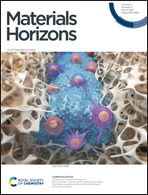Polarity control of DNA adsorption enabling the surface functionalization of CuO nanozymes for targeted tumor therapy†
Abstract
Nanomaterials with intrinsic catalytic activities (nanozyme) have drawn broad attention for various biomedical applications, with peroxidase-mimic nanozymes particularly attractive for cancer therapy due to their capability to catalyze the conversion of tumor-abundant H2O2 into more toxic hydroxyl radicals (˙OH) for effective tumor ablation. However, the facile surface modification of nanozymes for tumor-targeted delivery while retaining their catalytic activity remains a challenge. Here, we report an approach to functionalize the CuO nanozyme with DNA to enable targeted delivery and selective tumor destruction. We systematically studied the adsorption of DNA on the CuO surface, with special attention paid to the catalytic activity and DNA adsorption stability in the presence of various biological ligands. After gaining a fundamental understanding, a di-block DNA sequence was designed for adsorption on to the CuO surface, which allowed stable adsorption during in vivo circulation, passive accumulation into the tumor tissue, and the specific recognition of tumor cells, resulting in significant nanocatalytic tumor suppression in tumor xenograft mice models with no noticeable cytotoxicity. This work paves a way for the rational design of DNA-modified nanozymes for catalytic tumor therapy, and fundamentally, provides a new insight into the biointerface chemistry of CuO with DNA.



 Please wait while we load your content...
Please wait while we load your content...